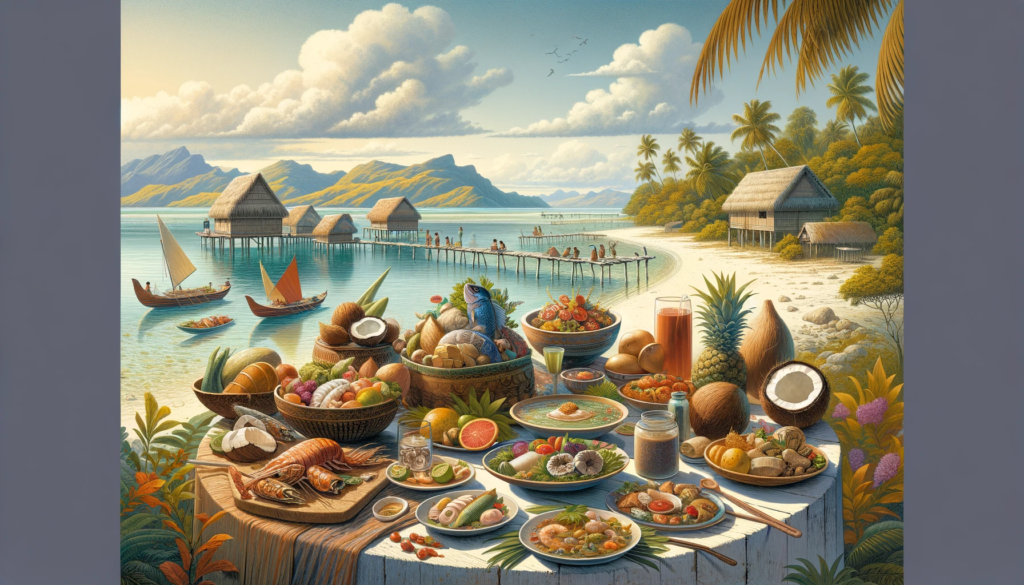Introduction to Kiribati’s Culinary Heritage
An Overview of the Gastronomic Traditions of Kiribati
Delving into the culinary traditions of Kiribati uncovers a history steeped in a deep connection with the ocean and the land. The gastronomic practices of this island nation were forged by the natural resources available and the ingenuity of its people. Traditional Kiribati cuisine reflects the islands’ bountiful sea-life and the tropical vegetation flourishing on the atolls. A minimalistic approach to spices and a reliance on fresh ingredients give Kiribati food its distinct, healthful quality. Fish, coconut, and root vegetables are staple components, often prepared using methods handed down through generations. These recipes narrate a tale of survival and adaptation and embody the essence of the Kiribati culture and community spirit.
Staple Ingredients in Kiribati Cooking
The Importance of Seafood, Coconut, and Pandanus Fruit
In Kiribati, the daily diet reflects the islands’ generous offerings. Seafood is the centerpiece of most meals, showcasing a variety of fish, shellfish, and other marine delicacies that define the Kiribati palate. Additionally, both versatile and abundant, coconuts and pandanus fruit play a crucial role in savory meals and sweet delights. In Kiribati cooking, coconut milk is a base for numerous dishes and a substitute for dairy. With its nutty and sweet profile, the pandanus fruit is often used in desserts or eaten raw. These ingredients are fundamental for flavor and key to the islands’ nutritional sustenance and food security.
Classic Dishes of Kiribati
Te Bua Toro Ni Baukin – Breadfruit in Coconut Milk
Te Bua Toro Ni Baukin is a cherished dish in Kiribati, epitomizing the harmonious blend of local ingredients. Breadfruit, a starchy fruit that grows in abundance, is the star of this recipe. When simmered in rich coconut milk, it transforms into a tender, creamy delight that speaks to the soul of Kiribati comfort food. This dish is usually served as a hearty component of a larger meal and exemplifies the simplicity and depth of flavors in traditional island cooking.
Palu Sami – A Fish and Taro Leaf Delight
Palu Sami is another traditional Kiribati dish showcasing the locals’ adeptness at combining the sea’s bounty and land. The dish is prepared with fresh fish wrapped in taro leaves, then slow-cooked with coconut milk. The taro leaves impart a unique, slightly smoky flavor to the fish while also adding a nutritious punch. Palu Sami’s method of preparation locks in flavors, resulting in a succulently cooked fish that is both delicate and aromatic.
Ika – Traditional Kiribati-style Sashimi
Ika is Kiribati’s answer to sashimi, made from the freshest catch from the Pacific Ocean. This delicacy involves thinly slicing raw fish and serving it with various condiments, such as soy sauce, coconut milk, or local citrus juices. It’s a testament to the simplicity of island cuisine and the exceptional seafood quality surrounding the atolls. Ika allows diners to experience the true, unadulterated flavor of the ocean, a fundamental aspect of Kiribati’s culinary identity.
Babai – A Unique Root Vegetable Dish
Babai is a type of giant swamp taro cultivated in specialized pits on the Kiribati islands. With its dense and starchy texture, this root vegetable is a substantial food source and a significant component of local diets. It can be boiled, steamed, or baked and often features as a filling side or main dish in meals. Babai is a symbol of the adaptability of the I-Kiribati, as it is grown and harvested with techniques specifically developed to thrive in the atoll’s environment.

Traditional Cooking Methods in Kiribati
The Use of Earth Ovens and Open Fire in Meal Preparation
Kiribati’s traditional cooking practices often involve earth ovens, known locally as ‘um’, and the use of open fires. An ‘um’ is essentially a pit dug in the ground, filled with hot stones, where food wrapped in leaves is slow-cooked, resulting in tender and flavorful dishes. Open fire cooking, on the other hand, imparts a distinctive smokiness to food, which is particularly favored for grilling fish or barbecuing meats. These methods are not just cooking techniques; they are an anchor of cultural identity and communal living, as preparing a meal in this way typically involves family and neighbors.
Techniques for Smoking and Sun-Drying Fish
Given the abundance of marine life, Kiribati has developed unique methods for preserving seafood. Smoking and sun-drying fish are traditional techniques that serve both to enhance the flavor and prolong the shelf-life of the catch. Smoking over coconut husks adds a profound depth to the fish, while sun-drying employs the tropical sun’s heat to achieve a chewy texture and concentrated taste. These practices not only represent a means of sustenance but also encapsulate the islanders’ ingenuity in using natural resources to their utmost benefit.
Eating Habits and Food Etiquette in Kiribati
Mealtime Customs and Traditional Eating Practices
In Kiribati, mealtime is more than just eating; it is an opportunity to come together and share. Traditional eating practices involve communal feasts, known as ‘botaki’, where food is often served on large shared plates or banana leaves. Sitting on the floor and eating with one’s hands is common, emphasizing sharing and showing respect for the food and companionship. The customs associated with eating reinforce the values of community cohesion and the collective enjoyment of the island’s natural bounty.

Celebrations and Festive Foods in Kiribati
Special Dishes for Holidays and Ceremonial Occasions
Kiribati celebrates various cultural and religious events with festive foods that hold special significance. During these occasions, dishes like ‘Te Buai’, a mix of seafood and root crops, and ‘Te Kababu’, a corned beef and pumpkin dish, take center stage. These ceremonial meals are not just about satiating hunger; they are intrinsic to Kiribati’s social fabric, commemorating important milestones, and strengthening community bonds through shared culinary heritage.
Modern Influences on Kiribati Cuisine
Contemporary Adaptations of Traditional Dishes
In recent years, Kiribati cuisine has experienced a gentle influx of modern influences that have brought about creative adaptations of traditional dishes. While the core elements remain grounded in the islands’ roots, there is now a growing trend of incorporating new ingredients and techniques into the culinary repertoire. Fusion dishes that marry Kiribati flavors with international cuisines are becoming more commonplace, offering an exciting twist to the traditional palate while celebrating the island’s gastronomic diversity.
The Influence of Global Foods on the Kiribati Diet
Globalization has widened the horizons of Kiribati’s dietary patterns, introducing ingredients and food products that were previously unavailable. Rice, flour, and canned goods, once rarities, have found their way into the everyday diet, influencing meal preparation and consumption habits. While these global foods provide variety, there remains a conscious effort within the community to maintain the integrity of their traditional diet, given its cultural and nutritional importance.
Preserving Kiribati’s Culinary Traditions
Efforts to Maintain Authenticity in Kiribati Cooking
Amidst the evolving food scenery, Kiribati has a strong movement to preserve and promote authentic culinary practices. Initiatives to document traditional recipes, cooking techniques, and the cultural significance of local dishes are underway. By teaching the younger generation about the importance of their culinary heritage, Kiribati ensures that its food traditions continue to thrive and remain an integral part of its cultural identity.
Preparing Kiribati Dishes at Home
Recipes and Tips for Cooking Kiribati Cuisine
For avid cooks and cultural enthusiasts wishing to explore Kiribati cuisine, there are many accessible recipes and cooking tips available. Emphasizing the use of fresh seafood, coconut, and an array of root vegetables, these recipes guide you through the joy of creating authentic Kiribati meals in your own kitchen. With a focus on simple, natural flavors and nutritious ingredients, preparing Kiribati dishes at home can be a delightful and gratifying journey into island culinary traditions.
FAQs on Traditional Kiribati Food
What Are the Key Ingredients in Kiribati Cuisine?
Kiribati cuisine is built on fresh, locally sourced ingredients that testify to the island’s rich natural resources. Key ingredients include an array of seafood like tuna, snapper, and clams, coconuts in various forms such as milk and oil, and starchy root vegetables like breadfruit and taro. These staple components are complemented by tropical fruits such as bananas, papayas, and pandanus fruit, creating a diverse palette of flavors unique to Kiribati’s culinary culture.
How Are Traditional Dishes Prepared in Kiribati?
Traditional dishes in Kiribati are prepared with simplicity and respect for the ingredients. Cooking methods often involve grilling over an open fire, boiling in coconut milk, or baking in earth ovens. Fish is commonly consumed raw, marinated, or gently cooked to preserve its delicate texture and natural flavor. Root vegetables are frequently boiled or baked, while the leaves of plants like taro are used for wrapping food before cooking, which imparts distinct aromatic flavors.
What is unique about Kiribati’s eating habits and food etiquette?
Kiribati eating habits and food etiquette reflect the cultural values of sharing and community. It is customary for meals to be eaten communally, and traditional feasts, or ‘botaki’, involve everyone dining together. Food is often served on large platters or banana leaves at the center of shared sitting spaces. Hand-eating is common, and utmost respect is shown towards the food consumed, emphasizing gratitude and appreciation for the meal shared among family members and guests.
What Types of Seafood Are Common in Kiribati Dishes?
Kiribati’s surrounding waters teem with a variety of seafood that is integral to the island’s diet. Tuna, both yellowfin and skipjack, are local favorites, often prepared raw as sashimi or cooked in coconut milk. Reef fish such as snapper, grouper, and parrotfish also feature prominently. In addition, clams, crabs, lobsters, and other shellfish are commonly used in many dishes. Seafood is valued not just as a food source but also reflects the deep connection between the I-Kiribati people and the ocean.
Are There Vegetarian Options in Kiribati Cuisine?
While seafood and meat play a significant role in Kiribati cooking, there are also vegetarian options available within the traditional diet. Dishes made from breadfruit, coconut, and various root vegetables like taro and babai can be delightful for vegetarians. The local pandanus fruit and an array of tropical fruits offer sweet alternatives or dessert options. With a bit of creativity, traditional recipes can be adapted to suit vegetarian and even vegan preferences by emphasizing the islands’ plentiful plant-based ingredients.
How Has Globalization Affected Kiribati Culinary Practices?
Globalization has introduced new ingredients and food products to Kiribati, leading to a subtle shift in culinary practices. Imported goods such as rice, canned meats, and processed snacks have become more common, particularly in urban areas. Despite these changes, there is a strong sense of pride in traditional cooking, and many I-Kiribati people continue to value and uphold the methods and ingredients that have been part of their heritage for generations, balancing the new with the old in their contemporary food landscape.
